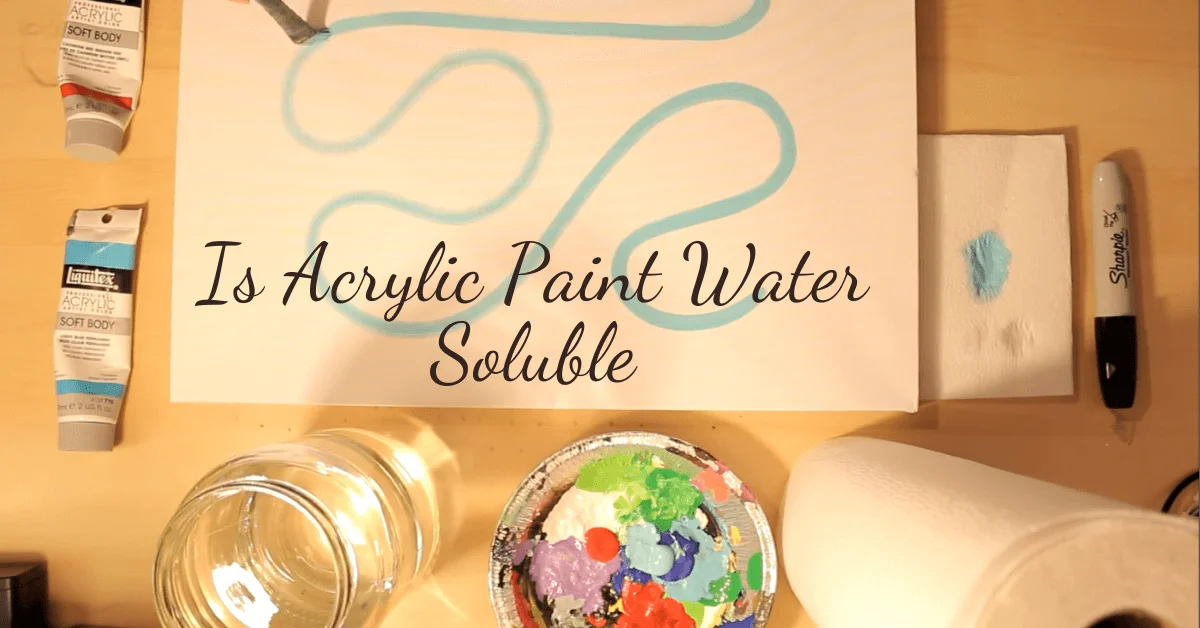Acrylic paint is one of the widely used paints for painting, decoration and designing on canvas, metal, wood, fabric and several other surfaces. The paint possesses excellent features ranging from fast drying to long-lasting.
There are two main categories of paints. The first one is oil-based paint, which is insoluble in water, while the second one is a water-based paint. So being water-based, is acrylic paint water soluble?
Yes, acrylic paint is water-soluble as long as it is fresh, i.e. inside a container or tube, but once it is applied to a surface and gets completely cured, it becomes water-resistant.
Read the post thoroughly to learn more about acrylic paint water solubility. In addition, you’ll learn how to thin and dilute acrylic paint. I’ll talk about some pros and cons of adding water to the paint as well.
Which Paint Is Insoluble In Water?
Water solubility is more about the chemistry of the substances than just physical mixing. It means the substances you will mix need to make chemical bonding to dissolve.
For example, when you add water content to water soluble acrylic paint, the pigment molecules make chemical bonding with the water molecules.
If these interactions are not formed, the paint will not dissolve in water, and the pigment molecules will float freely over the water’s surface, just like oil.
However, these chemical bondings are very weak in water-based paints, so the water can easily evaporate during drying.
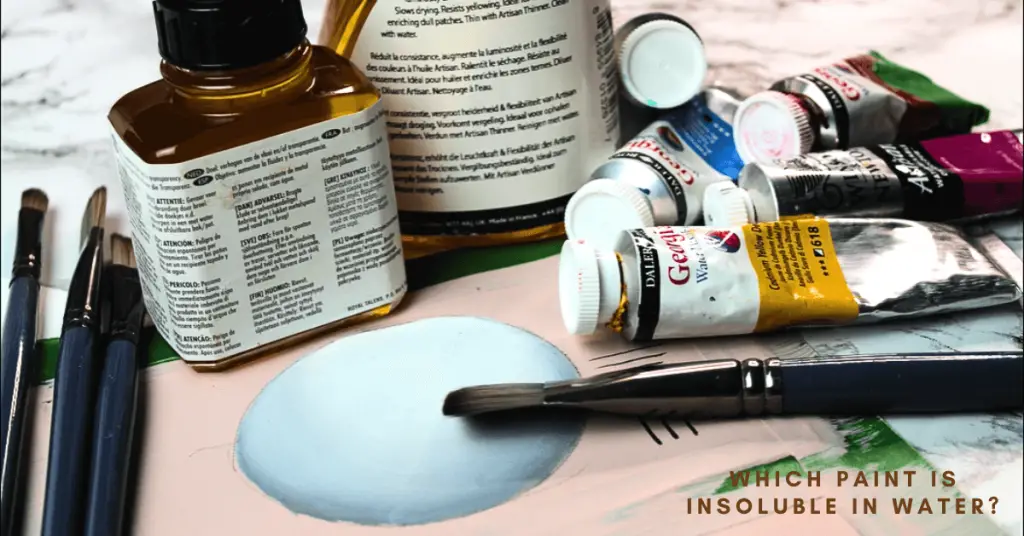
Acrylic Paint Chemistry (Composition)
To understand the solubility of acrylic paint in water more deeply, we must see its ingredients and composition. Acrylic paint is composed of three main ingredients.
- Solvent
Every painting needs a liquid medium for its composition and activity. This medium works as a vehicle to deliver the paint to a surface and is called a solvent.
Different paints utilise solvents like alcohol, hydrocarbons, acetone, oil etc. In the case of acrylic paint, the solvent is water.
- Binder
Another ingredient paint needs is a binder. As the name suggests, a binder helps in putting the pigment molecules in place. In the absence of the binder, the pigment molecules will disperse and don’t remain intact on a surface.
The binder is mostly a polymer substance with adhesive features; in most cases, it is a plastic material. In acrylic paint, the binder is an acrylic polymer.
- Pigment
The last thing any paint contains is pigment. It is the molecule that gives a specific colour to the paint. Pigments can be synthetic or naturally derived from various sources.
So water and binder together form an acrylic polymer emulsion in which pigment molecules are suspended.
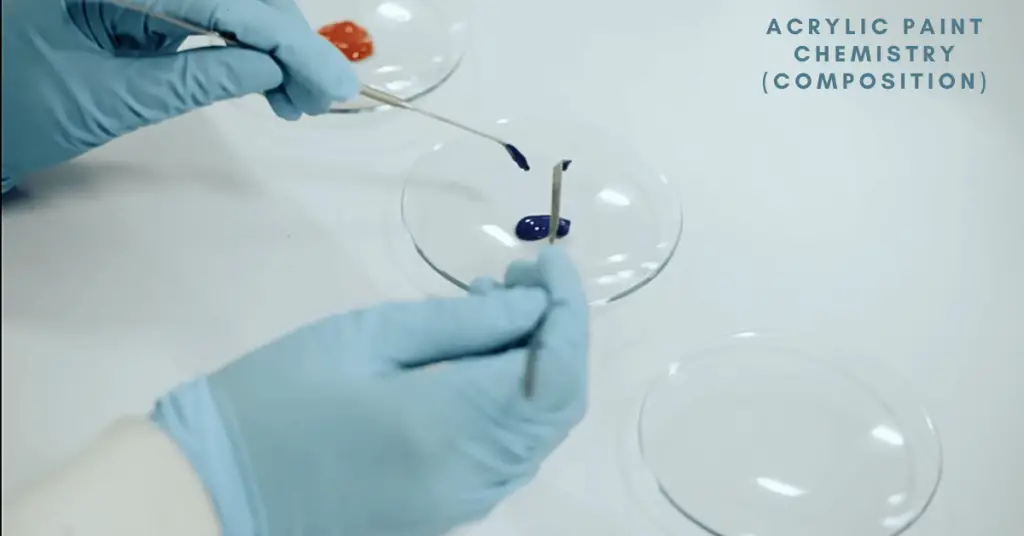
How To Dilute Acrylic Paint?
You can dilute acrylic paint by adding water or any compatible medium in an appropriate ratio. Here are the ways to thin or dilute acrylic paint.
- Water
Can you water down acrylic paint? The most obvious thing is using water to dilute acrylic paints to make them more flowy and liquid. The tricky thing about using water is not using too much. A good rule of thumb is to not dilute more than 28-30% of your mix with water.
So one-quarter water to one part paint is a good proportion. The point of diluting is obviously to make the paint more liquid fluid so that it applies better on the canvas and it allows for better gradients.
Using water, we dilute the pigment, making the paint a bit more transparent. Some people say that it makes the colour a lot less vibrant.
You might not want acrylic paint diluted with water if you’re an artist. Although there are other ways, I have been using water for years, and I find that it works as long as you don’t add too much.
The risk of using too much water would be to break up the binding of the acrylic paint so that on the canvas, it would adhere less well. Basically, with time it gets cracked or peeled off. So the maximum water should be 28-30% water.
- Matte Medium
The standard alternative to water is to use a matte medium. It is an amazing acrylic product, and I use it all the time as well. I use it to dilute the paint, but also I use it as a kind of glue in collage art. It’s Matt; it dries translucent.
It’s not fully liquid; it’s kind of like, halfway between water and gel, and again when diluting with Matte Medium, using 25% will ensure that the paint maintains its opacity. Contrary to water, if you use more matte medium, it won’t break up the paint and prevent it from sticking to the canvas properly.
When using 50-60% matte medium to paint, it becomes a glaze and a very translucent colour. Blazing is an interesting technique to overlap colours but play with transparency, especially for portraits and skin and maybe emulating some types of fabric.
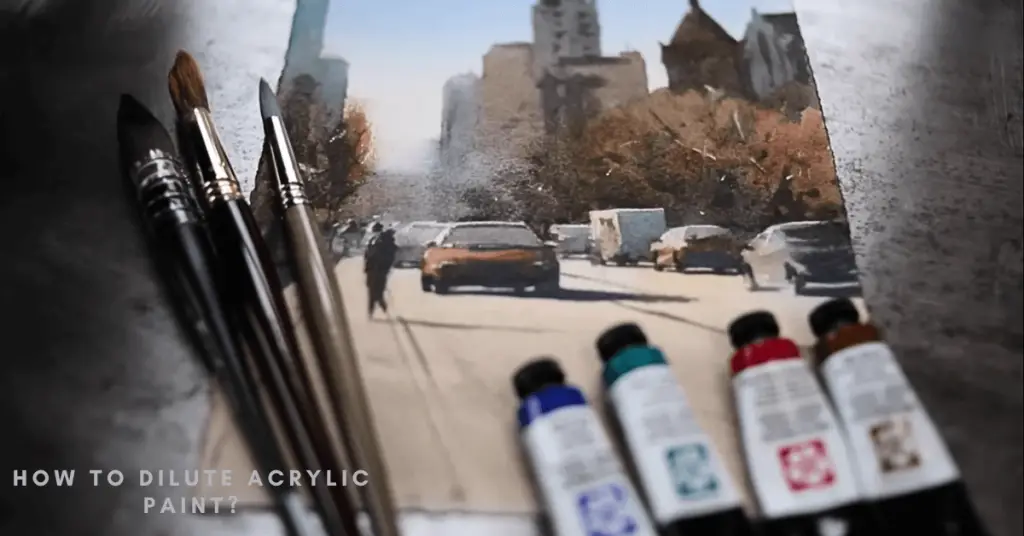
- Airbrush Medium
Another way to have acrylic paint be very liquidy but retain really good opacity is to use an airbrush medium. Airbrush medium is very liquid, but it’s a painting medium, so it won’t do that thing where it breaks up acrylic paint the way water will.
It’s suggested to use soft body paints in the proportion of 50:50 with an airbrush medium.
I have not tried this yet, but I am really curious to try it. I like to see side by side of water colour versus acrylic paint very diluted. I think that it would be interesting. So the optimal way to have a very diluted acrylic paint mix would be to use an airbrush medium as an alternative to water.
Because with airbrush medium, you can go up to 50%, keeping all the properties you want in acrylic paint.
- Liquitex Medium
And another really cool thing that I found out that I really didn’t know, maybe it’s obvious to somebody it wasn’t obvious to me. For instance, Liquitex, I’ve been using them for a really long time.
They have two consistencies in their paint, there is the soft body and the heavy body, and I never really thought much about it. I thought that the heavy body was a less diluted version of the soft body.
So I thought buying a heavy body was worth it because I could dilute myself and have the paint last longer, like have more paint essentially.
That’s not the case. According to Liquitex, both consistencies have the same opacity or vibrancy in pigment. So diluting heavy body paint automatically will make it less pigmented and a little bit more transparent.
Essentially if I wanted the heavy body to have the same consistency as the soft body, I would end up with a more transparent mix for the same consistency.
So the idea is to choose well from the two depending on your art style and what type of work you wanna do. The heavy body has that stickiness to it, and you can get great texture on the canvas if you like the big volume on the canvas.
Maybe you’re working with a palette knife and different modeling pastes and mediums, whereas the soft body is more of a traditional thinner layer of paints.
Advantages of Mixing Water With Acrylic Paint
There are many reasons people add water to the paint. Some of the reasons are discussed below. But before we proceed, there is a question, “How much water should be added to acrylic paint?”
No matter why you’re mixing water in acrylic paint, you must not add more than 28-30% (as per Liquitex guidelines) water in the paint because exceeding this limit will disturb the composition or proportion.
As I mentioned earlier, there is an acrylic emulsion in acrylic paint, which is formed by water and a binder. If you add too much water, the ratio of polymer to water is changed, causing in loss of the adhesion ability of the paint.
- Thinning The Paint
How to thin down acrylic paint? Well, here comes the role of water. If you want to thin down acrylic paint, add an appropriate amount of water.
Sometimes the paint gets too thick due to cold. The paint may get thick when you leave the lid of the container open. In this case, the paint can be recovered using water.
How to thin acrylic paint for canvas? If your paint is too viscous and not able to be applied to the canvas or if you require thin paint for your art, you may water down acrylic paint.
- Watercolour Effect
Sometimes adding water to paint is a requirement of your art or painting. For example, if you want to get a runny effect or abstract art effect, you’ll need thin paint. In this case, you can add water to the paint.
Again, make sure you don’t add more than 1\3 part water to the paint because the paint may lose its stickiness, and you’ll not be able to get a good runny effect.
- Cost Effective
Acrylic paint is dissolved in water for thinning. In other words, water is used as a thinner and is mixed in the paint because it is a cost-effective, cheap, and readily available method to thin down the paint.
Otherwise, you have to use a paint thinner which is specifically designed for acrylic paint and is costly. In short, water is a cheap alternative to paint thinner.
- Transparent Effect
Adding water to acrylic paint affects the vibrancy of the colour. It fades the colour and provides you with a more transparent look.
So if you’re looking for a lighter appearance of colours, you may use water to give a smoother and softer impression to your art and paintings.
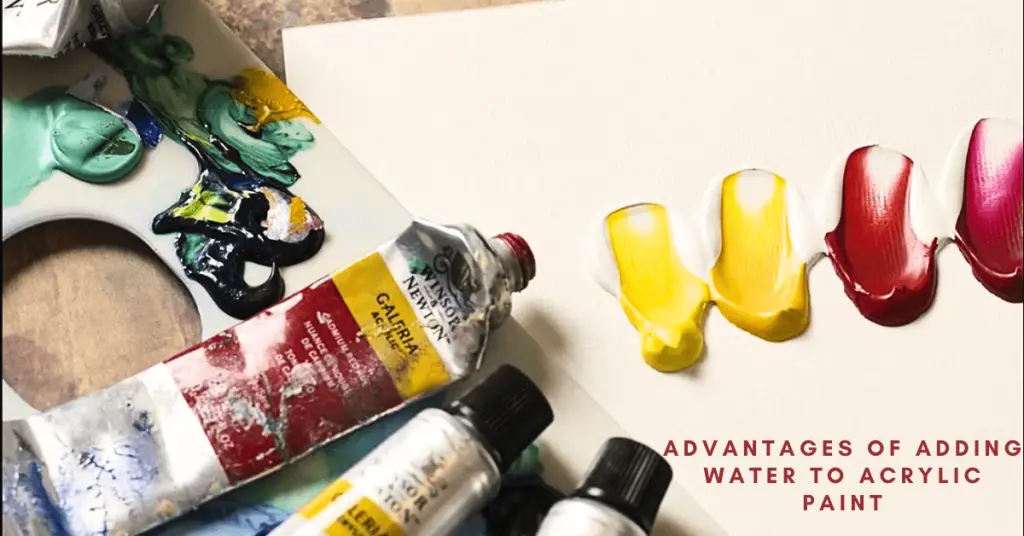
- Acrylic Ink
You can prepare acrylic ink at home using water and acrylic paint. Ink is nothing but diluted paint. So you’ll need to add enough quality water in order to liquefy the paint.
Acrylic ink can be used for many objectives, including lettering, sharp designs, naming, and many other artworks.
- Acrylic Pour Technique
I hope you have heard about the acrylic pour technique. It is a technique to produce abstract art on a surface using diluted acrylic paint.
Many artists use water to be mixed with the paint in order to get a diluted or liquified paint for this art.
Disadvantages of Mixing Water With Acrylic Paint
Adding water to acrylic paint may benefit you in many ways, but it has some drawbacks as well. Why water is not the best option for acrylic paint is discussed below.
- Altered Paint Consistency
The downside to using water for thinning paint is the change in the paint’s consistency. All the ingredients are present with the specific ratios in the paint, but adding water may disturb the ratio, which affects the vibrancy, opacity, extended last and other features of the paint.
- Low Coverage
Water thins down the paint, which reduces the coverage. It means the paint will not be able to cover the surface and gaps very well. On the other hand, thick acrylic paint, which is not diluted with water, has greater coverage.
- Reduced Adhesion
Water may reduce the adhesion of the paint, which causes it to peel sooner. In other words, the long-lasting nature of acrylic paint is compromised due to the addition of water and manipulation of the emulsion of the paint.
- Low Opacity
It is obvious that acrylic paint will lose opacity due to water. The reason is there are not enough molecules of pigment to balance the ratio of water and colour. So you’ll not get a dark colour or opaque appearance.
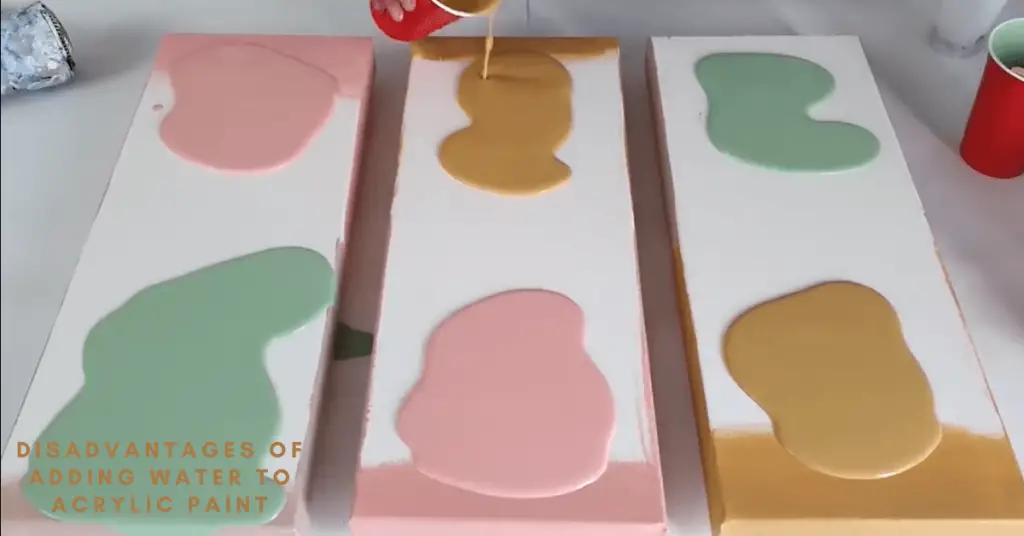
Best Option To Thin Down Acrylic Paint
As we saw, there are several drawbacks of adding water to acrylic paint along with the benefits, so what is the alternative of water, and what is the best option if we want to thin down acrylic water soluble paint?
Well, the best option is a medium. There are certain mediums that are specifically synthesised to be added to acrylic paint for thinning and recovering dried paints. You can find them online on Amazon or in a local hardware store.
These mediums consist of acrylic polymer and water only, which means they are actually acrylic paints without pigment. So adding them will not manipulate the consistency of the paint.
Things To Consider While Dissolving Acrylic Paint With Water
Is acrylic paint soluble in water? As I mentioned earlier, the paint can be dissolved in water, but you need to consider a few things to maintain the paint quality and minimise the chances of paint contamination. These tips will definitely help you a lot.
- Always use distilled or filtered water for paint. If you use tap water, it may contain contaminants that are not good for the paint and ruin its quality. Moreover, the contaminants can spoil the colour vibrancy and overall texture.
- The best practice is to use a small amount of acrylic medium along with water. It will help the paint retain the original composition as well as thin down the paint.
- Always stir the paint vigorously after adding water. In addition, avoid adding too much water at a time; instead, add a small amount and stir well before adding more water. It will help you gradually achieve the dilution you want.
Does Wall Paint Dissolve In Water?
The solubility of paint in water is decided by its ingredients. Most wall paints are oil-based, which is why they are not soluble in water.
However, they are soluble in hydrocarbon, alcohol, and acetone. So if you’re looking to dilute the wall paint, just add these compounds.
Does Enamel Paint Dissolve In Water?
Enamel paint is oil and petroleum-based. These solvents are resistant to water. So we can say enamel paint doesn’t dissolve in water.
Is Paint Soluble In Water?
No, all paints are not soluble in water. For example, oil-based dyes can’t be dissolved in water due to long hydrophobic chains. On the other hand, water-based paint is soluble in water.
Does Dry Acrylic Paint Dissolve In Water?
Once acrylic paint has dried, it forms a water-resistant film that is not easily soluble in water. While water can soften and rehydrate dry acrylic paint to some extent, it does not completely dissolve or break down the paint film. The water may help to loosen the paint’s adhesion to a surface that can help you to remove or scrape it off.
FAQs
Are acrylic paints water soluble?
Yes, acrylic paints are water soluble. However, to prevent the paint’s consistency from getting deteriorated, only mix one-third water in the paint, which is the maximum amount you can add.
Is acrylic water soluble after drying?
No, acrylic paint becomes resistant to water after drying completely. When the paint is wet, it can be dissolved in water, but once the water evaporates, it becomes water insoluble.
Does acrylic paint dissolve in water?
Yes, acrylic paint can be dissolved in water. It is done for diluting or thinning the paint. But make sure you don’t add too much water that it loses its quality.
Is acrylic paint waterproof?
Yes, acrylic paint is waterproof when it cures or dries completely. But if the painting remains damp for a long time, it can cause cracks and peels.
Do you use water with acrylic paint on canvas?
Yes, you can thin down acrylic with water when using it over the canvas. It is in fact, a good practice if you want the paint to adhere better to the canvas. Moreover, it helps you have better control over the paint.
Conclusion
So, is acrylic paint water soluble? Well, we can conclude that it’s all about the chemistry of the paints and the elements used in their formation. Some paints are water-repellent, like oils based, while others are water appealing, like acrylic paint.
That was all from my side. Please comment on your queries below. Thank You!
- How To Buff Acrylic Enamel Paint In 5 Easy Steps? Thorough Guidance - February 2, 2024
- How To Make Acrylic Paint More Opaque? 10 Effective Methods - February 1, 2024
- How To Sketch On Canvas Before Acrylic Painting? Draw Like a Pro - January 31, 2024

